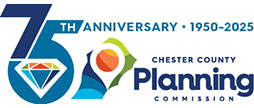Connect Metrics
Advance efficient, reliable, and innovative transportation, utility, and communications infrastructure systems that responsibly serve thriving and growing communities.
Metric 15 — Active Transportation
Track the length of new multi-use trails, sidewalks, and bike lanes created in the county.
Metric Results
Since 2018 the length of trails located withing the DVRPC Circuit Trail Corridors gradually rose from 35 to 40 miles. There were 0.1 miles added in 2024. Similarly, sidewalks gradually rose from 914 to 1,003 miles, an addition of 6.6 miles for 2024. Bike lanes had remained unchanged from 2018, until 2024 when they saw a minor increase from 13.3 to 13.4 miles.

Metric 16 — Public Transportation
Track transit ridership trips within the county including bus routes, regional rail service, and AMTRAK.
Metric Results
AMTRAK ridership for Chester County dropped during the pandemic. Ridership, which was 1,738 in 2018, dropped to 415 in 2021. But by 2024, it has nearly recovered to 1,461. The 2024 ridership is 84.1% of what it was in 2018. During the pandemic, SEPTA bus routes that extend into Chester County decreased from over 9,800 average weekday riders to under 4,000. There has since been a gradual recovery to 7,827 riders. Their 2024 ridership is 79.7% of what it was in 2018. There is limited data on SEPTA commuter rail ridership, but available data suggests that average daily ridership is still far less than what it was pre-pandemic. The most current ridership data from 2023 is 46.5% of what it was in 2019. This change is likely influenced by Chester County residents who previously commuted daily to Philadelphia, but now have a full- or part-time remote work schedule.



Metric 17 — Improved Travel Time
Monitor the average travel time on selected major highways during peak hours on weekdays.
Metric Results
For 2024, the time needed to travel 15 miles in Chester County was 16.6 minutes, a modest drop from 2023 when it was 17.0. As a result of the pandemic, the time needed to travel 15 miles in Chester County dropped from over 19 in 2018 minutes to under 16 in 2021. Since 2021, the commute time rose, but it still ranges between 16 and 17 minutes. This is almost certainly due to an increase in remote work and fewer people on the road during traditional commuting times.

Metric 18 — Coordinating Utilities with Growth Areas
Track development units connecting to public sewer and water services that will be located in designated growth areas.
Metric Results
Since 2018, the percentage of proposed units that are consistent with Landscapes3 in terms of both public sewer and water service, has steadily grown. For this metric to be consistent with Landscapes3, a development in a growth area should use public water and sewer systems. In 2024, 90.3% of growth area proposals were consistent. This follows a general trend dating back to 2018, in which consistency is typically at or above 90%. For this metric, a development in a rural or agriculture landscape should use an on-lot sewer system and private well water. In 2024, 99.4% of growth area proposals were consistent. However, data from 2018 to 2024 show that consistency changes from year to year, sometimes dipping into the range of 50 to 70%. This is likely due to sewer lines being extended out from growth areas and into rural areas.




